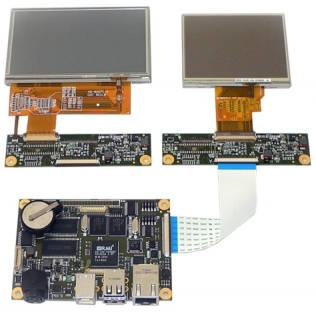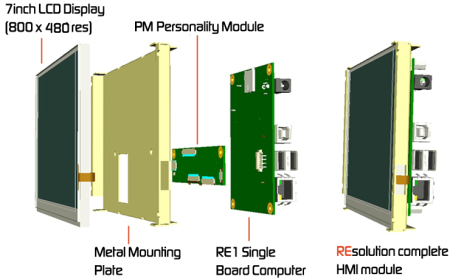HMI SBC gains larger display, Linux BSP
Nov 20, 2009 — by Eric Brown — from the LinuxDevices Archive — 20 viewsBlue Chip Technology has released an updated version of its small SBC (single board computer) aimed at embedded HMI (human machine interface) applications. Based on a MIPS32-based RMI Au1100 processor, the new RE1 “REsolution” SBC adds a full Linux board support package and a 7-inch LCD module, says the company.
As we reported in July, Blue Chip's RE1 is a small (3.93 x 2.75 inches) SBC that targets HMI designs for instrumentation, multimedia applications, and mobile devices. Supporting custom screen choices of up to 800 x 600 pixels, the device was previously offered with a variety of off-the-shelf "personality module" and LCD display option, ranging up to a 4.3-inch, 480 x 272 display. The company has now added a 7-inch, 800 x 480 resolution widescreen LCD display option.

RE1 (bottom) with personality boards and optional displays
The RE1 was previously released with drivers for Linux or Windows CE. Now, Blue Chip has released a full Linux BSP, "which includes all the tools and guidance needed to kickstart any Linux based embedded project," says the company. The Linux BSP is said to include a Linux kernel, root file system, Yamon bootloader, and sample configurations.
The RE1 is equipped with a MIPS32-based RMI Alchemy Au1100 processor. The Au1100 consumes 1.5 Watts when clocked at 333MHz or 2 Watts when clocked at 500MHz. The device's low power dissipation figures make it a candidate for being operated via POE (Power Over Ethernet), courtesy of its standard 10/100 Ethernet port, says Blue Chip.

Blue Chip RE1
(Click to enlarge)
Pin headers on the board are said to provide access to two additional USB 1.1 host ports, AC '97 audio, two RS232 ports, one RS485 port, 12 GPIOs, IrDA infrared, and an eight-bit expansion interface. For more information, including a block diagram and a spec list, see our previous coverage, here.

The RE1 connects to a choice of displays, including new 7-inch model (left) via personality modules
(Click to enlarge)
Availability
The new version of the RE1 appears to be available now for Linux (with full BSP) or Windows CE. One-off pricing starts at 100 Pounds (about $165 U.S.), with a 2013 "life statement," says Blue Chip Technology. More information may be found here.
This article was originally published on LinuxDevices.com and has been donated to the open source community by QuinStreet Inc. Please visit LinuxToday.com for up-to-date news and articles about Linux and open source.